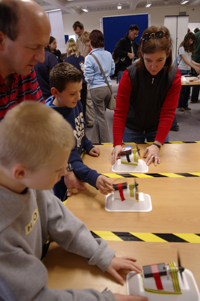Many of the Department's engineers were involved in this year's Science Festival.
Scale Model of Solar System
Professor Andrew Palmer led the building of a scale model of the solar system at Churchill College. He recounted how the event went. "The model was to a scale of 1:10^10 (1 to 10,000,000,000). On that scale the Sun is the size of a large grapefruit, and Neptune is about 500m away, the distance from the centre of Churchill to the chapel. The mean position of Pluto would have taken it beyond the Churchill boundary fence, but we took advantage of the fact that Pluto has a very eccentric orbit, so that sometimes it comes within the orbit of Neptune.
The planets are tiny, mostly the size of a peppercorn or a pea, though Jupiter and Saturn are a little larger. Each of the children was asked to chose a planet, make a model from plasticine, and hang the model in a circle cut out from a large piece of white card. On the card they could write or draw anything they liked: poems, factual data, ideas about what animals might live there, etc. Books were provided as source material. The white card was taped to a stick that could be pushed into the ground.
A total station theodolite was mounted on a tripod at the sun position. The model sun hung on the tripod. The children could choose how to set out the model planets, either by electronic distance measurement from the tripod, or by GPS (geographic positioning system) or for the inner planets by a simple measuring tape.
Once the system was set out, we went up the tower at the Møller Centre to see the whole system spread out before us. We then did a 'comet walk', starting at Pluto and at each planet pausing to let the child who had chosen that planet tells us about it.
At the end one of the children said: 'That was fun!'."

Hover Magic
Joy Warde, the Department's Outreach Officer, organised the Hover magic and Rocket launch pad events. "Can you build a hovercraft? Local children were invited to design and make their own hovercraft. Engineering students were on hand to help the children with their designs." The event was a great success! Over 1800 children, parents and guardians visited the event. We gave away 600 motor and propeller driven hovercraft and over 500 balloon driven hovercraft to local children."
Rocket Launch Pad
Primary school pupils aged 9-11 came along to the Department for half a day to build rocket launch pad structures out of tubes. They then made paper rockets and had fun launching them. Over the week over 200 pupils attended from 8 local primary schools.
Other engineering events included:
Bending the Rules: Small is Different
A number of physical properties, e.g. colour, ability to conduct electricity, and magnetic behaviour depend upon phenomena less than one hundredth the diameter of a human hair. The Nanoscience Centre opened its doors for those who wanted to find out what happens when the size of an object is this small.
On the Millennium Bridge
Allan McRobie gave a talk on why it wobbled, and why the key to understanding lies with the behaviour of fire flies in South East Asia.
A Wonderful Thing is a Phillips Machine
Allan McRobie gave a demonstration of the Phillips Machine, a 1950's invention that can calculate the workings of the national economy using pipes, pumps, pulleys and buckets.

